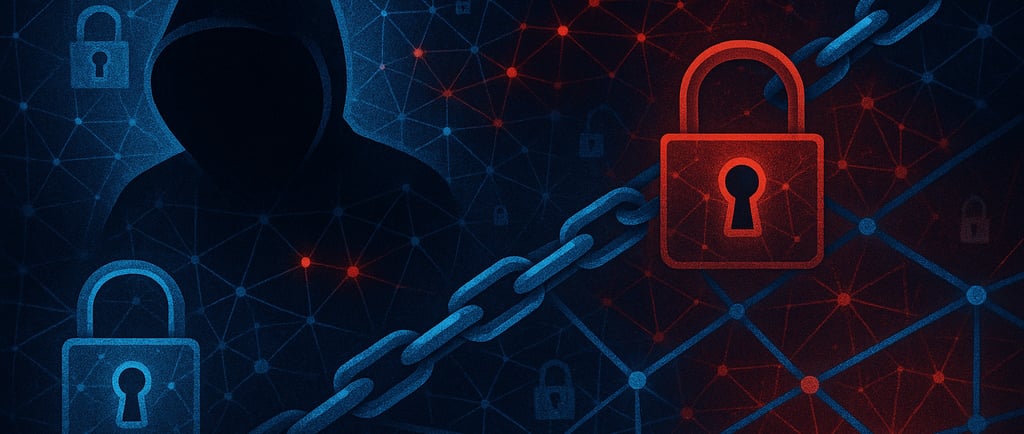
The Evolution of Cyber Threats
Targeted Attacks and Ransomware Trends in 2025
Shane Brown
6/27/20256 min read


The Evolution of Cyber Threats: Targeted Attacks and Ransomware Trends in 2025
The cybersecurity landscape continues to evolve at an unprecedented pace, with 2025 marking a significant shift in how threat actors approach their campaigns. Today's cybercriminals are more strategic, sophisticated, and patient than ever before, employing a combination of advanced technical capabilities and refined social engineering techniques to breach even the most well-defended organizations.
The Rise of Scattered Spider: Masters of Human Exploitation
Among the most concerning developments in the threat landscape is the emergence of Scattered Spider, a sophisticated threat group that has redefined what it means to conduct targeted cyberattacks. Also known by security researchers as UNC3944, Octo Tempest, and 0ktapus, this group has demonstrated remarkable tactical flexibility throughout 2025.
What sets Scattered Spider apart is their methodical approach to sector targeting. Rather than casting a wide net, they focus intensively on one industry at a time before pivoting to the next. In 2025, we witnessed their strategic shift from targeting UK retail organizations to focusing primarily on the U.S. insurance sector. This targeted approach allows them to develop deep expertise in specific industry vulnerabilities and operational patterns.
The group's most devastating weapon isn't sophisticated malware or zero-day exploits—it's their mastery of social engineering. Members are primarily English-speaking individuals believed to be based in the United States, United Kingdom, and Canada. This linguistic and cultural familiarity gives them a significant advantage when conducting attacks against Western targets.
The Help Desk Vulnerability
Scattered Spider has perfected the art of exploiting IT help desk operations, often the weakest link in organizational security. Their approach is disturbingly simple yet effective: they impersonate company employees and convince support staff to reset passwords or provide system access. What makes these attacks particularly dangerous is the level of preparation involved. Attackers often possess detailed personally identifiable information about their victims, enabling them to bypass standard identity verification procedures.
The group's coordinated campaigns demonstrate their operational sophistication. In May 2025, major UK retailers including Marks & Spencer, Co-op, and Harrods fell victim to what appeared to be a synchronized assault. These attacks typically follow a predictable pattern: initial contact with help desk staff, successful credential compromise, and rapid deployment of ransomware variants like DragonForce.
From a technical perspective, Scattered Spider maintains an impressive infrastructure, with 81% of their domains designed to impersonate technology vendors. They leverage advanced phishing frameworks like Evilginx and employ various social engineering methods, including voice phishing, to gain initial access. Their victim selection is strategically focused, with 70% of targets belonging to technology, finance, and retail trade sectors.
The Ransomware Paradox: Fewer Attacks, Greater Impact
While headlines might suggest otherwise, global ransomware incidents have actually shown a declining trend in recent months. May 2025 recorded 393 attacks, representing a 6% decrease from April's 416 incidents. This marked the third consecutive month of declining ransomware attacks, following a significant 31% drop in April compared to March.
However, these declining numbers mask a more complex reality. The first quarter of 2025 alone witnessed 2,472 potential ransomware attacks—representing 40% of the entire 2024 annual total. This concentration suggests that while monthly attack volumes may be declining, the overall threat intensity remains exceptionally high.
The Evolution of Ransomware Operations
The ransomware ecosystem continues to evolve with new threat actors gaining prominence through the Ransomware-as-a-Service model. Safepay emerged as the most active ransomware group in May 2025, responsible for 70 attacks. This marked the first time the group, active only since November 2024, appeared in the top threat actors list.
Security researchers suspect that Safepay may represent a rebranding of several well-known groups including LockBit, ALPHV/BlackCat, and INC Ransomware. This theory would explain their rapid scaling capabilities and sophisticated operational structure. The RaaS model continues to lower barriers to entry for cybercriminals, democratizing access to advanced ransomware capabilities.
Industrial Sector Under Siege
Perhaps no sector has experienced a more dramatic escalation in cyber threats than industrial operations. The first quarter of 2025 saw a staggering 46% surge in ransomware attacks against industrial entities compared to Q4 2024. This trend reflects the growing recognition among cybercriminals that industrial targets offer unique opportunities for maximum disruption and leverage.
Manufacturing bears the heaviest burden, accounting for 68% of industrial ransomware incidents in Q1 2025. The sector's critical role in global supply chains makes it an attractive target, as disruptions can cascade across multiple industries and geographies.
Operational Technology Under Attack
Industrial attackers are employing increasingly sophisticated techniques specifically designed for operational technology environments. The W32.Worm.Ramnit trojan, which targets OT systems, experienced a 3,000% increase in Q1 2025. This malware is specifically engineered to steal credentials from industrial operators, highlighting the dangerous convergence of traditional cybercrime and industrial-specific threats.
The integration of IT and OT systems has created new attack vectors that cybercriminals are actively exploiting. Notable incidents include attacks on critical infrastructure such as the South African Weather Service, which severely disrupted aviation and agricultural forecasting capabilities.
The Human Factor: Social Engineering in the AI Age
Social engineering remains the most effective tool in the cybercriminal arsenal, with 98% of cyberattacks involving some form of human manipulation. The integration of artificial intelligence into social engineering campaigns is creating unprecedented challenges for security professionals.
AI-powered tools are enabling attackers to create more convincing and personalized attacks at industrial scale. The use of AI-generated deepfakes, automated scam interactions, and immersive digital experiences is facilitating what experts call "hyper-personalised fraud at an industrial scale." These technological advancements are making social engineering attacks increasingly difficult to detect and defend against.
Multi-Factor Authentication Under Pressure
Even multi-factor authentication, long considered a security gold standard, is coming under sustained attack. Common bypass techniques include MFA prompt bombing, where attackers overwhelm users with authentication requests until they accept one to stop the alerts. SIM swapping attacks, where criminals convince mobile carriers to port victim phone numbers to attacker-controlled devices, remain a persistent and growing threat.
Legacy authentication protocols continue to provide avenues for MFA bypass, as older systems and applications may not support modern authentication methods. Attackers also exploit trusted network connections and attempt to compromise already-authenticated sessions to circumvent MFA requirements entirely.
Sector-Specific Targeting Trends
Insurance Industry in the Crosshairs
The insurance sector has emerged as a primary target for sophisticated threat actors, particularly Scattered Spider. Major U.S. insurance companies are facing increased scrutiny from threat intelligence groups following high-profile incidents involving Erie Insurance and Aflac.
The insurance industry's access to sensitive personal information, including Social Security numbers and health data, makes it an attractive target for both ransomware operators and data thieves. The sector's critical role in the broader economy also increases pressure on victims to pay ransoms to restore operations quickly.
Retail Sector Vulnerabilities
The retail sector continues facing intense pressure, with consumer discretionary attacks rising from 73 incidents in April to 102 in May 2025. High-profile targets have included Victoria's Secret, Adidas, Cartier, and Peter Green Chilled. The sector's vulnerability stems from its reliance on point-of-sale systems, the high cost of operational disruptions, and access to valuable customer data.
Looking Forward: Emerging Threats and Defense Strategies
AI-Driven Vulnerabilities
The integration of artificial intelligence into both attack and defense strategies is creating new dynamics in the threat landscape. AI-related vulnerabilities, such as prompt-injection attacks, are becoming increasingly concerning as organizations rapidly adopt AI technologies. These attacks can manipulate AI systems to expose sensitive data or perform unauthorized actions, even without extensive system permissions.
State-Sponsored and Criminal Convergence
The traditional boundaries between cybercriminal activity and state-sponsored operations are blurring. Nation-state actors are beginning to collaborate with ransomware operators, while state-sponsored groups are adopting ransomware tactics for both financial gain and strategic objectives. This convergence is creating more sophisticated and persistent threats that combine the resources of state actors with the profit motives of cybercriminals.
Building Resilient Defenses
Organizations must fundamentally adapt their defensive strategies to address this evolving threat landscape. Success requires a comprehensive approach that addresses both technical and human factors:
Enhanced Identity Security remains paramount. Organizations must implement robust identity verification procedures and provide specialized training for help desk staff to recognize and respond to social engineering attempts.
Comprehensive MFA Deployment should extend across all systems, including legacy applications. Regular reviews of conditional access policies ensure that authentication requirements remain effective against evolving bypass techniques.
Sector-Specific Awareness enables organizations to prepare for industry-targeted campaigns. Understanding threat actor preferences and attack patterns helps organizations prioritize their defensive investments.
Advanced Threat Detection capabilities, particularly endpoint detection and response tools, must be capable of identifying hands-on-keyboard attacks and sophisticated social engineering attempts that traditional security tools might miss.
Continuous Security Training should include realistic scenarios and regular phishing simulations that reflect current threat actor techniques and targeting methods.
The current threat landscape demonstrates that while technical defenses continue to evolve, the human element remains the most significant vulnerability in most organizations. Success in defending against targeted attacks and ransomware requires acknowledging this reality and building security programs that address both technological and human factors with equal sophistication and attention.
As we progress through 2025, organizations that invest in comprehensive security strategies—combining advanced technical controls with robust human-centered defenses—will be best positioned to withstand the increasingly sophisticated and persistent threats that define today's cybersecurity landscape.
Additional Resources for Further Reading
CISA Cybersecurity & Infrastructure Security Agency - Comprehensive guidance on ransomware prevention and incident response: https://www.cisa.gov/
NIST Cybersecurity Framework - Industry standards and best practices for organizational cybersecurity: https://www.nist.gov/cyberframework
SANS Institute - Leading cybersecurity training and threat intelligence resources: https://www.sans.org/
Krebs on Security - Independent investigative reporting on cybersecurity threats and trends: https://krebsonsecurity.com/
The Cyber Threat Alliance - Collaborative intelligence sharing on emerging cyber threats: https://www.cyberthreatalliance.org/
Innovate
Building websites and securing your digital presence.
Connect
Support
Info@sinistergatedesigns.com
© Sinister Gate Designs, LLC 2025. All rights reserved.
